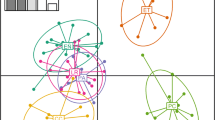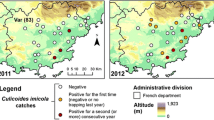Abstract
Fine scale patterns of genetic structure and dispersal in Triatoma infestans populations from Argentina was analysed. A total of 314 insects from 22 domestic and peridomestic sites from the locality of San Martín (Capayán department, Catamarca province) were typed for 10 polymorphic microsatellite loci. The results confirm subdivision of T. infestans populations with restricted dispersal among sampling sites and suggest inbreeding and/or stratification within the different domestic and peridomestic structures. Spatial correlation analysis showed that the scale of structuring is approximately of 400 m, indicating that active dispersal would occur within this distance range. It was detected difference in scale of structuring among sexes, with females dispersing over greater distances than males. This study suggests that insecticide treatment and surveillance should be extended within a radius of 400 m around the infested area, which would help to reduce the probability of reinfestation by covering an area of active dispersal. The inferences made from fine-scale spatial genetic structure analyses of T. infestans populations has demonstrated to be important for community-wide control programs, providing a complementary approach to help improve vector control strategies.




Similar content being viewed by others
References
Ceballos LA, Piccinali RV, Marcet PL, Vazquez-Prokopec GM, Cardinal MV, Schachter-Broide J et al (2011) Hidden sylvatic foci of the main vector of Chagas disease Triatoma infestans: threats to the vector elimination campaign? PLoS Negl Trop Dis 5(10):e1365
Cecere MC, Gürtler RE, Canale DM, Chuit R, Cohen JE (2002) Effects of partial housing improvement and insecticide spraying on the reinfestation dynamics of Triatoma infestans in rural northwestern Argentina. Acta Trop 84:101–116
Cecere MC, Vazquez-Prokopec GM, Gürtler RE, Kitron U (2004) Spatio-temporal analysis of reinfestation by Triatoma infestans (Hemiptera: Reduviidae) following insecticide spraying in a rural community in northwestern Argentina. Am J Trop Med Hyg 71:803–810
Double MC, Peakall R, Beck NB, Cockburn A (2005) Dispersal, philopatry and infidelity: dissecting local genetic structure in superb fairy-wrens (Malurus cyaneus). Evolution 59:625–635
Excoffier L, Smouse PE, Quattro JM (1992) Analysis of molecular variance inferred from metric distances among DNA haplotypes: application to human mitochondrial DNA restriction data. Genetics 131:479–491
Excoffier L, Laval G, Schneider S (2005) Arlequin (version 3.0): an integrated software package for population genetics data analysis. Evol Bioinform Online 1:47–50
Fredsted T, Pertoldi C, Schierup MH, Kappeler PM (2005) Microsatellite analyses reveal fine-scale genetic structure in grey mouse lemurs (Microcebus murinus). Mol Ecol 14:2363–2372
García BA, Zheng L, Pérez de Rosas AR, Segura EL (2004) Isolation and characterization of polymorphic microsatellite loci in the Chagas’ disease vector Triatoma infestans (Hemiptera: Reduviidae). Mol Ecol Notes 4:568–571
Goudet J (2001) FSTAT, a program to estimate and test gene diversities and fixation indices (version 2.9.3). Available from http://www.unil.ch/izea/softwares/fstat.html. Updated from Goudet (1995)
Goudet J, Raymond M, De Meeus T, Rousset F (1996) Testing differentiation in diploid populations. Genetics 144:1931–1938
Gurevitz JM, Kitron U, Gütler RE (2007) Flight muscle dimorphism and heterogeneity in flight initiation of field-collected Triatoma infestans (Hemiptera: Reduviidae). J Med Entomol 44:186–191
Gürtler RE, Canale DM, Spillmann C, Stariolo R, Salomón OD, Blanco S et al (2004) Effectiveness of residual spraying of peridomestic ecotopes with deltamethrin and permethrin on Triatoma infestan s in rural western Argentina: a district-wide randomized trial. Bull World Health Organ 82(3):196–205
Gürtler RE, Kitron U, Cecere MC, Segura EL, Cohen JE (2007) Sustainable vector control and management of Chagas disease in the Gran Chaco, Argentina. Proc Natl Acad Sci USA 104:16194–16199
Hardy OJ, Vekemans X (2002) SPAGeDi (version 1.2): a versatile computer program to analyse spatial genetic structure at the individual or population levels. Mol Ecol Notes 2:618–620
Lehane MJ, McEwen PK, Whitaker CJ, Schofield CJ (1992) The role of temperature and nutritional status in flight initiation by Triatoma infestans. Acta Trop 52:27–38
Loiselle BA, Sork VL, Nason J, Graham C (1995) Spatial genetic structure of a tropical understory shrub, Psychotria officinalis (Rubiacea). Am J Bot 82:1420–1425
Lorca M, García A, Contreras MC, Schenone H, Rojas A (2001) Evaluation of a Triatoma infestans elimination program by the decrease of Trypanosoma cruzi infection frequency in children younger than 10 years, Chile, 1991–1998. Am J Trop Med Hyg 65:861–864
Marcet PL, Mora MS, Cutrera AP, Jones L, Gürtler RE, Kitron U et al (2008) Genetic structure of Triatoma infestans populations in rural communities of Santiago del Estero, northern Argentina. Infect Genet Evol 8:835–846
Nei M (1987) Molecular evolutionary genetics. Columbia University Press, New York
Paetkau D, Slade R, Burden M, Estoup A (2004) Genetic assignment methods for the direct, real-time estimation of migration rate: a simulation-based exploration of accuracy and power. Mol Ecol 13:55–65
Peakall R, Smouse PE (2006) GENALEX 6: genetic analysis in Excel. Population genetic software for teaching and research. Mol Ecol Notes 6:288–295
Peakall R, Ruibal M, Lindenmayer DB (2003) Spatial autocorrelation analysis offers new insights into gene flow in the australian bush rat, Rattus fuscipes. Evolution 57:1182–1195
Pérez de Rosas AR, Segura EL, García BA (2007) Microsatellite analysis of genetic structure in natural Triatoma infestans (Hemiptera: Reduviidae) populations from Argentina: its implication in assessing the effectiveness of Chagas’ disease vector control programmes. Mol Ecol 16:1401–1412
Pérez de Rosas AR, Segura EL, Fichera L, García BA (2008) Macrogeographic and microgeographic genetic structure of the Chagas’ disease vector Triatoma infestans (Hemiptera: Reduviidae) from Catamarca, Argentina. Genetica 133:247–260
Pérez de Rosas AR, Segura EL, García BA (2011) Molecular phylogeography of the Chagas’ disease vector Triatoma infestans in Argentina. Heredity 107:71–79
Piry S, Alapetite A, Cornuet J-M, Paetkau D, Baudouin L, Estoup A (2004) GENECLASS2: a software for genetic assignment and first-generation migrant detection. J Hered 95:536–539
Pizarro JC, Gilligan LM, Stevens L (2008) Microsatellites reveal a high population structure in Triatoma infestans from Chuquisaca, Bolivia. PLoS Negl Trop Dis 2:e202
Pritchard JK, Stephens M, Donnelly P (2000) Inference of population structure using multilocus genotype data. Genetics 155:945–959
Rannala B, Mountain JL (1997) Detecting immigration by using multilocus genotypes. Proc Natl Acad Sci USA 94:9197–9201
Rassi A Jr, Rassi A, Marin-Neto JA (2010) Chagas disease. Lancet 375:1388–1402
Richer W, Kengne P, Cortez MR, Perrineau MM, Cohuet A, Fontenille D et al (2007) Active dispersal by wild Triatoma infestans in the Bolivian Andes. Trop Med Int Health 12:759–764
Schofield CJ, Lehane MJ, McEwen P, Catala SS, Gorla DE (1992) Dispersive flight by Triatoma infestans under natural climatic conditions in Argentina. Med Vet Entomol 6:51–56
Schweigmann N, Vallvé S, Muscio O, Ghillini M, Alberti A, Wisnivesky-Colli C (1988) Dispersal flight by Triatoma infestans in an arid area of Argentina. Med Vet Entomol 2(4):401–404
Silveira A, Vinhaes M (1999) Elimination of vector-borne transmission of Chagas disease. Mem Inst Oswaldo Cruz 94:405–411
Smouse PE, Peakall R (1999) Spatial autocorrelation analysis of individual multiallele and multilocus genetic structure. Heredity 82:561–573
Weir BS, Cockerham CC (1984) Estimating F-statistics for the analysis of population structure. Evolution 38:1358–1370
Werman SD, Davidson EH, Britten RJ (1990) Rapid evolution in a fraction of the Drosophila nuclear genome. J Mol Evol 30:281–289
World Health Organization (1994) Chagas disease. Elimination of transmission. Wkly Epidemiol Rec 69:38–40
Wright S (1951) The genetical structure of populations. A Eug 15:323–354
Acknowledgments
This research was supported by the grants from the Agencia Nacional de promoción Científica y Tecnológica (FONCYT), the Consejo Nacional de Investigaciones Científicas y Técnicas (CONICET) of Argentina, and the Secretaría de Ciencia y Tecnología de la Universidad Nacional de Córdoba. E. L. Segura and B. A. García are Career Investigator of CONICET.
Author information
Authors and Affiliations
Corresponding author
Rights and permissions
About this article
Cite this article
Pérez de Rosas, A.R., Segura, E.L., Fusco, O. et al. Fine-scale genetic structure in populations of the Chagas’ disease vector Triatoma infestans (Hemiptera, Reduvidae). Genetica 141, 107–117 (2013). https://doi.org/10.1007/s10709-013-9710-0
Received:
Accepted:
Published:
Issue Date:
DOI: https://doi.org/10.1007/s10709-013-9710-0




